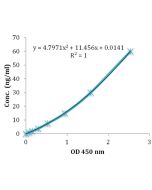Cookie Policy: This site uses cookies to improve your experience. You can find out more about our use of cookies in our Privacy Policy. By continuing to browse this site you agree to our use of cookies.
AdipoGen Life Sciences
anti-Zinc-α-2-glycoprotein (human), mAb (Zagy-2)

| Product Details | |
|---|---|
| Synonyms | Zn-α-2-GP; Zn-α-2-Glycoprotein; ZAG; ZA2G; AZGP1; ZNGP1 |
| Product Type | Monoclonal Antibody |
| Properties | |
| Clone | Zagy-2 |
| Isotype | Mouse IgG1 |
| Source/Host | Purified from concentrated hybridoma tissue culture supernatant. |
| Immunogen/Antigen | Recombinant human zinc-α-2-glycoprotein. |
| Application |
Western Blot: (1μg/ml) |
| Crossreactivity | Human |
| Specificity |
Recognizes human zinc-α-2-glycoprotein. |
| Purity | ≥95% (SDS-PAGE) |
| Purity Detail | Protein G-affinity purified. |
| Concentration | 1mg/ml |
| Formulation | Liquid. In PBS containing 10% glycerol and 0.02% sodium azide. |
| Isotype Negative Control | |
| Shipping and Handling | |
| Shipping | BLUE ICE |
| Short Term Storage | +4°C |
| Long Term Storage | -20°C |
| Handling Advice |
After opening, prepare aliquots and store at -20°C. Avoid freeze/thaw cycles. |
| Use/Stability | Stable for at least 1 year after receipt when stored at -20°C. |
| Documents | |
| MSDS |
 Download PDF Download PDF |
| Product Specification Sheet | |
| Datasheet |
 Download PDF Download PDF |
Zinc-α-2-glycoprotein (ZAG), first identified in the 1960s, derives its name from its precipitation from human plasma upon the addition of zinc salts. ZAG has since been found in secretory epithelial cells and in a range of body fluids. ZAG is identical to a lipid mobilizing factor isolated from the urine of patients with cancer cachexia and stimulates lipolysis in in vivo experiments. Due to its expression in and secretion from adipocytes, ZAG is considered an adipokine. Recently the clinical significance of ZAG has been clarified. ZAG expression in adipocytes is inversely related to fat mass, thus it is intimately involved in the maintenance of body weight in mice and humans. Epidemiological studies have uncovered an association between ZAG and plasma cholesterol. The non-synonymous single nucleotide polymorphism rs4215 in ZAG is associated with plasma cholesterol and obesity. Structurally ZAG possesses a class I major histocompatibility complex (MHC) protein fold. It is distinct from other members of this protein family in that it is soluble, rather than being anchored to plasma membranes and it associates with prolactin inducible protein rather than β2 microglobulin. Similar to peptide antigen-presenting class I MHC molecules, ZAG possesses an open apical groove between its α1 and α2 domain helices.








